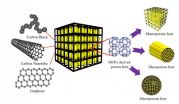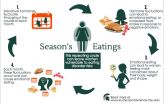Future batteries: Lithium-sulfur with a graphene wrapper
UK-China team has designed a novel cathode for rechargeable lithium-sulfur batteries featuring a thin 'wrap sandwich' sheet of graphene
2014-12-16
(Press-News.org) WASHINGTON D.C., December 16, 2014 -- What do you get when you wrap a thin sheet of the "wonder material" graphene around a novel multifunctional sulfur electrode that combines an energy storage unit and electron/ion transfer networks? An extremely promising electrode structure design for rechargeable lithium-sulfur batteries.
Lithium-sulfur batteries are of great commercial interest because they boast theoretical specific energy densities considerably greater than those of their already-well-established cousin, lithium ion batteries.
In the journal APL Materials, from AIP Publishing, a team of researchers led by Dr. Vasant Kumar at the University of Cambridge and Professor Renjie Chen at the Beijing Institute of Technology describe their design of a multifunctional sulfur cathode at the nanolevel to address performance-related issues such as low efficiency and capacity degradation.
Metal organic frameworks (MOFs) have attracted plenty of attention recently, thanks to wide-ranging applications in hydrogen storage, carbon dioxide sequestration, catalysis and membranes. And to create their cathode, the team tapped MOF "as a template" to produce a conductive porous carbon cage -- in which sulfur acts as the host and each sulfur-carbon nanoparticle acts as energy storage units where electrochemical reactions occur.
"Our carbon scaffold acts as a physical barrier to confine the active materials within its porous structure," explained Kai Xi, a research scientist at Cambridge. "This leads to improved cycling stability and high efficiency." They also discovered that by further wrapping the sulfur-carbon energy storage unit within a thin sheet of flexible graphene speeds the transport of electrons and ions.
What's behind the improved capacity? Fast charge-transfer kinetics are made possible by an interconnected graphene network with high electrical conductivity, according to the team. Their work shows that the composite structure of a porous scaffold with conductive connections is a promising electrode structure design for rechargeable batteries.
This work provides a "basic, but flexible, approach to both enhance the use of sulfur and improve the cycle stability of batteries," Xi said. "Modification of the unit or its framework by doping or polymer coating could take the performance to a whole new level."
In terms of applications, the novel battery design's unique integration of energy storage with an ion/electron framework has now opened the door for fabrication of high-performance non-topotactic (not involving a structural change to a crystalline solid) reactions-based energy storage systems.
What's next for the team? "We'll focus on fabricating hybrid free-standing sulfur cathode systems to achieve high-energy density batteries, which will involve tailoring novel electrolyte components and building lithium 'protection layers' to enhance the electrochemical performance of batteries," noted Xi.
INFORMATION:
The article, "Graphene-wrapped sulfur/metal organic framework (MOF)-derived microporous carbon composite for lithium sulfur batteries," is authored by Renjie Chen, Teng Zhao, Tian Tian, Shuai Cao, Paul R. Coxon, Kai Xi, David Fairen-Jimenez, R. Vasant Kumar and Anthony K. Cheetham. It will appear in the journal APL Materials on December 16, 2014. After that date, it can be accessed at: http://scitation.aip.org/content/aip/journal/aplmater/2/12/10.1063/1.4901751
About the Journal
APL Materials is a new open access journal featuring original research on significant topical issues within the field of materials science. See: http://aplmaterials.aip.org
[Attachments] See images for this press release:

ELSE PRESS RELEASES FROM THIS DATE:
2014-12-16
Analysts at the Energy Department's National Renewable Energy Laboratory (NREL) have used statistical analyses and detailed case studies to better understand why solar market policies in certain states are more successful. Their findings indicate that while no standard formula for solar implementation exists, a combination of foundational policies and localized strategies can increase solar photovoltaic (PV) installations in any state.
In the report, "The Effect of State Policy Suites on the Development of Solar MarketsPDF," NREL researchers examined a variety of policy- ...
2014-12-16
People who occupy the extreme ends of the political spectrum, whether liberal or conservative, may be less influenced by outside information on a simple estimation task than political moderates, according to new research published in Psychological Science, a journal of the Association for Psychological Science.
The research, conducted by psychological scientists Mark J. Brandt and Anthony Evans of Tilburg University and Jarret T. Crawford of The College of New Jersey, suggests that because political extremists hold their own beliefs to be superior to the beliefs of others, ...
2014-12-16
New Rochelle, NY, December 16, 2014-Consuming caffeinated or sugary drinks can affect the body's metabolism, causing changes in heart and respiratory rate and weight gain. The results of a new study exploring whether individuals respond differently to caffeinated drinks that do or do not contain sugar and to sugar alone are published in Journal of Caffeine Research: The International Multidisciplinary Journal of Caffeine Science, a peer-reviewed publication from Mary Ann Liebert, Inc., publishers. The article is available free on the Journal of Caffeine Research website ...
2014-12-16
Eliminating health disparities between races is a goal of many groups and organizations, but a team of sociologists suggests that finding the reasons for the differences in the timing of black and white deaths may be trickier than once thought.
Life expectancies for black people are shorter and more uncertain, on average, than to those of whites, according to Glenn Firebaugh, Roy C. Buck Professor of American Institutions and professor of sociology and demography, Penn State. A higher lifespan variability -- the variability in the ages at which people die -- among blacks ...
2014-12-16
Unauthorized immigrants who previously have been removed from the United States are more than 2.5 times more likely to be rearrested after leaving jail, and are likely to be rearrested much more frequently than those who have never been removed, according to a new RAND Corporation study.
The findings generally support strategies adopted by federal immigration authorities and some law enforcement agencies to focus their immigration enforcement efforts on immigrants who previously have been removed, who are viewed as posing a bigger criminal threat.
Researchers studied ...
2014-12-16
Unlike in mathematics, it is rare to have exact solutions to physics problems.
"When they do present themselves, they are an opportunity to test the approximation schemes (algorithms) that are used to make progress in modern physics," said Michael Strickland, Ph.D., associate professor of physics at Kent State University.
Strickland and four of his collaborators recently published an exact solution in the journal Physical Review Letters that applies to a wide array of physics contexts and will help researchers to better model galactic structure, supernova explosions ...
2014-12-16
The genetic abnormality that drives the bone cancer Ewing sarcoma operates through two distinct processes - both activating genes that stimulate tumor growth and suppressing those that should keep cancer from developing. These findings by Massachusetts General Hospital (MGH) investigators, published in the November issue of Cancer Cell, may lead to new therapies targeting these aberrant mechanisms.
The second most common bone cancer in children and young adults, Ewing sarcoma is caused by a chromosomal translocation - switching of genetic segments between two different ...
2014-12-16
EAST LANSING, Mich. - 'Tis the season of plenty of food and drink. While celebrating should be joyful, for some women, it's not. All the holiday temptations can add another layer to an already complicated biological process.
It's well known that women undergo hormonal changes every month due to the menstrual cycle. These changes can cause women to eat more, which is a natural, biological occurrence.
However, Michigan State University Foundation Professor Kelly Klump has found that the increased food intake causes some women to become much more preoccupied with their ...
2014-12-16
ITHACA, N.Y. - In the fight against global warming, carbon capture - chemically trapping carbon dioxide before it releases into the atmosphere - is gaining momentum, but standard methods are plagued by toxicity, corrosiveness and inefficiency. Using a bag of chemistry tricks, Cornell materials scientists have invented low-toxicity, highly effective carbon-trapping "sponges" that could lead to increased use of the technology.
A research team led by Emmanuel Giannelis, the Walter R. Read Professor of Engineering in the Department of Materials Science and Engineering, has ...
2014-12-16
HOUSTON -- (Dec. 16, 2014) -- In one of the most comprehensive laboratory studies of its kind, Rice University scientists traced the uptake and accumulation of quantum dot nanoparticles from water to plant roots, plant leaves and leaf-eating caterpillars.
The study, one of the first to examine how nanoparticles move through human-relevant food chains, found that nanoparticle accumulation in both plants and animals varied significantly depending upon the type of surface coating applied to the particles. The research is available online in the American Chemical Society's ...
LAST 30 PRESS RELEASES:
[Press-News.org] Future batteries: Lithium-sulfur with a graphene wrapper
UK-China team has designed a novel cathode for rechargeable lithium-sulfur batteries featuring a thin 'wrap sandwich' sheet of graphene



